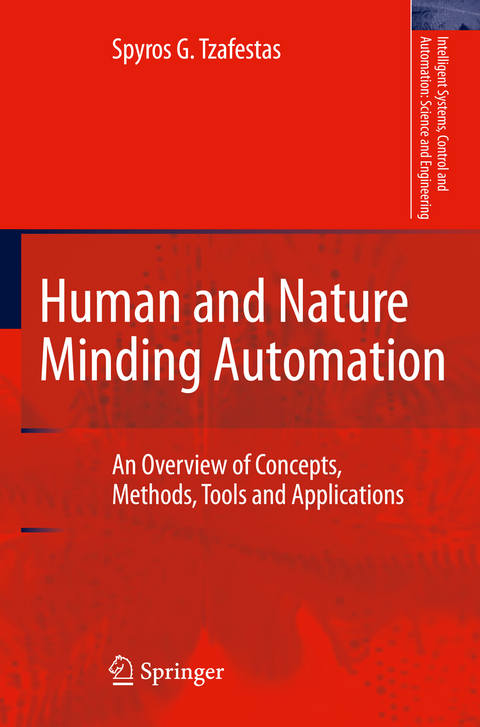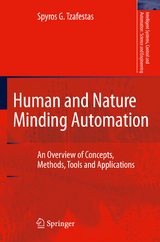Human and Nature Minding Automation
Springer (Verlag)
9789048135615 (ISBN)
Spyros G. Tzafestas received the B.Sc. in Physics (1963) and Graduate Diploma in Electronics (1965) from Athens University, Diploma of Electrical Engineering, from Imperial College (1967), M.Sc. (Eng.) in Control from London University (1967) and Ph.D. in Systems and Control from Southampton University, England (1969). From 1969 to 1973 he was Research Leader at the Computer Science Division of the Nuclear Research Center "Demokritos", Athens. From 1973 to 1984 he was Professor of Automatic Control at the University of Patras, and from 1985 to 2006 he was Professor of Control and Robotics at the National Technical University of Athens (NTUA), Greece. Temporary visiting teaching and / or research positions include : University of Calabria, Italy (1985, 1987), University of Delft, The Netherlands (1991) and MIT, USA (1992). He is currently Director of the Institute of Communication and Control Systems, and as a Professor Emeritus he is leading the Intelligent Automation Systems Research Group engaged with research carried out in ICCS-NTUA mainly in the framework of national and European projects. Dr Tzafestas is the Recipient of D.Sc. of Southampton University (1978), and Honorary Doctorates of the Technical University of Munich (Dr.-Ing. E.h., 1997) and the Ecole Centrale de Lille (Dr. Ing.-Honoris Causa, 2003). He has published 30 edited research books, 60 book chapters and over 700 Journal and Conference technical papers in the field of control, robotics and Intelligent Systems. He has been the coordinator of national and EU projects in the fields of IT, Intelligent systems, robotics, control and CIM. He is an associate editor of 15 Journals, and he was the Editor – in – Chief of the Journal of Intelligent and Robotic Systems (1988-2006) and of the Book Series "Micro processor – Based and Intelligent Systems Engineering, Kluwer (1993-2006). Presently, he is the Editor of the Springer book series on Intelligent Control and Automation Systems. He is a Fellow of IEE, now IET (London), a Life Fellow of IEEE (New York) and a Member of ASME, NYAS and the Hellenic Technical Chamber (TEE). He received the Greek Society of Writers’ Award and the Ktesibios Award from the IEEE Mediterranean Control Association (2001). Dr Tzafestas has over the years organized and / or chaired several international conferences (IEEE, IMACS, SIRES, IASTED, EUCA).
Preface; Outline of the Book; Chapter 1: Automation, Humans, Nature, and Development; 1.1 Introduction; 1.2 The Field of Automation; 1.3 Brief History of Control and Automation; 1.4 The Principle of Feedback1.5 The Humans in Automation; 1.6 Automation in the Nature; 1.7 Social Issues of Automation; 1.8 Human Development and Modernization; 1.8.1 Human Development Components; 1.8.2 Modernization; 1.8.3 Human Development Index; 1.8.4 Life Expectancy, Literary and Standard of Living; 1.8.5 Human Development Report; Chapter 2: Human Factors in Automation (I): Building Blocks, Scope, and a First Set of Factors; 2.1 Introduction2.2 The Human Factors Field: Building Blocks and Scope; 2.2.1 Building Blocks; 2.2.2 The Human Features; 2.2.3 Human-Automation Relation; 2.2.4 Automation; 2.2.5 Goals and Scope of the Human Factors Field; 2.3 Human Factors in Automation System Design and Development; 2.3.1 General Issues; 2.3.2 Developmental Elements; 2.3.3 System Development Concepts; 2.4 The Workload Factor in Automation; 2.5 Three Key Human Factors in Automation; 2.5.1 Allocation of Function; 2.5.2 Stimulus-Response Compatibility; 2.5.3 Internal Model of the Operator; 2.6 The Operator Reliance Factor; Chapter 3:Human Factors in Automation (II): Psychological, Physical Strength, and Human Error Factors: 3.1 Introduction; 3.2 Psychological Factors; 3.2.1 Job Satisfaction; 3.2.2 Job Stress; 3.2.3 A Psychosocial Stress Model; 3.3 Physical Strength; 3.4 Human Bias; 3.5 Human Error; 3.6 Human Values and Human Rights; Chapter 4: Human – Machine Interaction in Automation (I): Basic Concepts and Devices: 4.1 Introduction; 4.2 Applications of Human – Machine Interactive Systems; 4.3 Methodologies for the Design of Human – Machine Interaction Systems; 4.4 Keys and Keyboards; 4.5 Pointing Devices; 4.6 Screen Design; 4.7 Work Station Design; 4.7.1 Physical Layout Factors; 4.7.2 Work Method Factors; 4.7.3 Video Display Terminal Factors; Chapter 5: Human – Machine Interaction inAutomation (II): Advanced Concepts and Interfaces; 5.1 Introduction; 5.2 Graphical User Interfaces; 5.2.1 General Issues; 5.2.2 Design Components of Graphical Interfaces; 5.2.3 Windowing Systems; 5.2.4 Components of Windowing Systems; 5.3 Types and Design Features of Visual Displays; 5.3.1 Visual Display Type; 5.3.2 Further Design Features of Visual Displays; 5.4 Intelligent Human-Machine Interfaces; 5.5 Natural Language Human-Machine Interfaces; 5.6 Multi-Modal Human-Machine Interfaces ; 5.7 Graphical Interfaces for Knowledge-Based Systems; 5.8 Force Sensing Tactile Based Human-Machine Interfaces; 5.9 Human-Machine Interaction via Virtual Environments; 5.10 Human-Machine Interfaces in Computer-Aided Design; Chapter 6:; Supervisory and Distributed Control in Automation: 6.1 Introduction; 6.2 Supervisory Control Architectures; 6.2.1 Evolution of Supervisory Control; 6.2.2 Rasmussen’s Architecture; 6.2.3 Sheridan’s Architecture; 6.2.4 Meystel’s Nested Architecture; 6.3 The Task Analysis and Task Allocation Problems in Automation: How much and when to Automate?; 6.4 Distributed Control Architectures; 6.4.1 Historical Remarks; 6.4.2 Hierarchical Distributed Systems; 6.4.3 Distributed Control and System Segmentation; 6.5 Discrete Event Supervisory Control; 6.6 Behavior-Based Architectures; 6.6.1 Subsumption Architecture; 6.6.2 Motor Schemas Architecture; 6.7 Discussion; Chapter 7: Implications of Industry, Automation, and Human Activity to Nature; 7.1 Introduction; 7.2 The Concepts of Waste and Pollution Control; 7.2. Industrial Contaminants; 7.2.1 Organic Compounds; 7.2.2 Metals and Inorganic Nonmetals; 7.3 Impact of Industrial Activity on the Nature; 7.3.1 Air Pollution; 7.3.2 Global Warming, Ozone Hole, Acid Rain and Urban Smog; 7.3.2.1 Global Warming and Green House Effect; 7.3.2.2 Ozone Hole; 7.3.2.3 Acid Rain; 7.3.2.4 Urban Smog; 7.3.3 Solid Waste Disposal; 7.3.4 Water Pollution; 7.4 Energy Consumption and Natural Resources Depletion; 7.5 Three MajorProblems of the Globe Caused by Human Activity (Deforestation, Desertification, Decreasing Biodiversity); 7.6 Environmental Impact: Classification by Human Activity Type; Chapter 8: Human-Minding Automation: 8.1 Introduction; 8.2 System-Minding Design Approach; 8.3 Human-Minding Automation System Design Approach; 8.4 Human-Minding Interface Design in Automation Systems; 8.4.1 User-Needs Analysis; 8.4.2 Task Analysis; 8.4.3 Situation Analysis and Function Allocation; 8.5 The Human Resource Problem in Automation; 8.5.1 Allocation of System Development Resources; 8.5.2 Investment in Human Resources; 8.5.3 Innovation and Technology Transfer; 8.6 Integrating Decision Aiding and Decision Training in Human-Minding Automation; 8.7 International Safety Standards of Automation Systems; 8.8 Overlapping Circles Representation of Human Minding Automation Systems; Chapter 9: Nature-Minding Industrial Activity and Automation: 9.1 Introduction; 9.2 Life-Cycle and Environmental Impact Assessments; 9.2.1 Life-Cycle Assessment; 9.2.2 Environmental Impact Assessment; 9.3 Nature-Minding Design; 9.4 Pollution Control Planning; 9.5 Natural Resources-Energy Conservation and Residuals Management; 9.5.1 Water Conservation; 9.5.2 Energy Conservation; 9.5.3 Residuals Management; 9.6 Fugitive Emissions Control and Public Pollution Control Programs; 9.6.1 Fugitive Emissions Control; 9.6.2 Public Pollution Control Programs; 9.7 Environmental Control Regulations; 9.7.1 General Issues; 9.7.2 Environmental Regulations in the United States; 9.7.3 International and European Environmental Control Regulations; 9.7.3.1 Climate Change; 9.7.3.2 Biodiversit; 9.7.3.3 Environment and Health; 9.8 The Concept of Sustainability; 9.9 Environmental Sustainability Index; 9.10 A Practical Guide Towards Nature-Minding Business-Automation Operation ; 9.10.1 The Four Environmental R-Rules; 9.10.2 Four More Nature-Minding Rules; 9.11 Nature-Minding Economic Considerations; 9.12 Nature-Minding Organizations; Chapter 10:Modern Automation Systems in Practice: 10.1 Introduction; 10.2 Office Automation Systems; 10.3 Automation in Railway Systems; 10.4 Automation in Aviation Systems; 10.4.1 Aircraft Automation; 10.4.2 Air Traffic Control; 10.5 Automation in Automobile and Sea Transportation; 10.5.1 Advanced Traveler Information Systems; 10.5.2 Collision Avoidance and Warning System; 10.5.3 Automated Highway Systems; 10.5.4 Vision Enhancement Systems; 10.5.5 Advanced Traffic Management Systems; 10.5.6 Commercial Vehicle Operation; 10.5.7 Sea Transportation; 10.6 Robotic Automation Systems; 10.6.1 Material Handling and Die Casting; 10.6.2 Machine Loading and Unloading; 10.6.3 Welding and Assembly; 10.6.4 Machining and Inspection; 10.6.5 Drilling, Forging and other Fabrication Applications; 10.6.6 Robot Social and Medical Services; 10.6.7 Assistive Robotics; 10.7 Automation in Intelligent Buildings; 10.8 Automation of Intra-and Inter-Organizational Processes in CIM; 10.8.1 Intra-Organizational Automation; 10.8.2 Inter-Organizational Automation; 10.9 Automation in Continuous Process Plants; 10.10 Automation in Environmental Systems; 10.11 Discussion on Human-and Nature-Minding Automation and Technology Applications; Chapter 11: Mathematical Tools for Automation Systems I: Modeling and Simulation: 11.1 Introduction; 11.2 Deterministic Models; 11.3 Probabilistic Model; 11.3.1 Discrete Probability Mode; 11.3.2 Continuous Probability Model; 11.3.3 Baye’s Updating Formula; 11.3.4 Statistics; 11.4 Entropy Model; 11.5 Reliability and Availability Models; 11.5.1 Definitions and Properties; 11.5.2 Markov Reliability Model; 11.6 Stochastic Processes and Dynamic Models; 11.6.1 Stochastic Processes; 11.6.2 Stochastic Dynamic Models; 11.7 Fuzzy Sets and Fuzzy Models; 11.7.1 Fuzzy Sets; 11.7.2 Fuzzy Systems; 11.8 System Simulation; 11.8.1 Simulation of Dynamic Systems; 11.8.1.1 Euler Simulation Technique; 11.8.1.2 Runge Kutta Simulation Technique; 11.8.2 Simulation of Probabilistic Model; Chapter 12;Mathematical Tools for Automation Systems II: Optimization, Estimation, Decision, and Control: 12.1 Introduction.; 12.2 System Optimization; 12.2.1 Static Optimization; 12.2.1.1 Theory; 12.2.1.2 Computational Optimization Algorithms; 12.2.2 Dynamic Optimization; 12.2.2.1 Dynamic Programming; 12.2.2.2 Calculus of Variations; 12.2.2.3 Minimum Principle; 12.2.3 Genetic Optimization; 12.3 Learning and Estimation; 12.3.1 Least-Squares Parameter Estimation; 12.3.2 Recursive Least Squares Parameter Estimation; 12.3.3 Least Squares State Estimation: Kalman Filter; 12.3.3.1 Discrete-Time Filter; 12.3.3.2 State Prediction; 12.3.3.3 Continuous-Time Filter; 12.3.4 Neural Network Learning; 12.3.4.1 The Multilayer Perceptron; 12.3.4.2 The Radial Basis Function Network; 12.4 Decision Analysis; 12.4.1 General Issues; 12.4.2 Decision Matrix and Average Value Operators; 12.4.3 Fuzzy Utility Function; 12.5 Control; 12.5.1 Classical Control; 12.5.2 Modern Control; 12.5.2.1 Model Matching and Eigenvalue Control; 12.5.2.2 Optimal Control; 12.5.2.3 Stochastic Control; 12.5.2.4 Predictive Control; 12.5.2.5 Adaptive Control; 12.5.2.6 Robust Control; 12.5.2.7 Intelligent Control; 12.6 Concluding Remarks; References; Index; About the Author.
| Erscheint lt. Verlag | 18.12.2009 |
|---|---|
| Reihe/Serie | Intelligent Systems, Control and Automation: Science and Engineering ; 41 |
| Zusatzinfo | XX, 346 p. |
| Verlagsort | Dordrecht |
| Sprache | englisch |
| Maße | 155 x 235 mm |
| Themenwelt | Sachbuch/Ratgeber ► Natur / Technik |
| Informatik ► Software Entwicklung ► User Interfaces (HCI) | |
| Informatik ► Theorie / Studium ► Künstliche Intelligenz / Robotik | |
| Technik ► Elektrotechnik / Energietechnik | |
| Technik ► Maschinenbau | |
| Technik ► Umwelttechnik / Biotechnologie | |
| ISBN-13 | 9789048135615 / 9789048135615 |
| Zustand | Neuware |
| Informationen gemäß Produktsicherheitsverordnung (GPSR) | |
| Haben Sie eine Frage zum Produkt? |
aus dem Bereich




